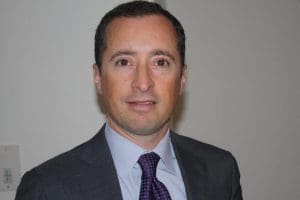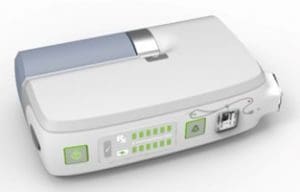
Fabian Tenenbaum of Bellerophon Therapeutics.
Scientists at Bellerophon Therapeutics progress new therapy for deadly lung diseases
By James Brewer
A big advance in therapy looks to be in sight for millions of people who suffer from serious lung disease.
Nasdaq-listed Bellerophon Therapeutics is targeting unmet medical needs through novel therapies and delivery systems.
Its team is working on the treatment of pulmonary arterial hypertension, a progressive and fatal disease, of which women in their early 50s are among the most frequent sufferers. The problem may result from smoking or environmental factors, but there is no certain cause.
Currently approved medications slow down progression, but do not stop it. Patients eventually die from right ventricular failure.
During visits to London, Zurich and other financial centres Fabian Tenenbaum, chief executive of Bellerophon, has been updating investors, who include financial institutions, on the company’s development of innovative drugs and devices to deliver treatment.
The clinical-stage biotherapeutics company aims to transform the lives of people with cardiopulmonary and cardiac ailments.

INOpulse portable device.
Problems for patients stem from the growth of cells lining the inner lung which constricts the arteries. Many treatments, such as prostacyclins (used anticoagulant and to dilate blood vessels) have side effects and can be invasive. The only definitive treatment is a lung transplant, which is available only to a minority of patients.
Median life expectancy where pulmonary hypertension is associated with chronic obstructive pulmonary disease is only four years, and many people have to be confined to hospital. Some 5% of the 12m people treated for chronic pulmonary ailment in the US are in this category.
Mr Tenenbaum said that his company’s work is focused on developing nitric oxide-based therapies for outpatient management of such chronic diseases. It has a portable, lightweight delivery system – the size of a thick book – which can even be used by patients in their home.
Bellerophon anticipates making a new-drug application to the US Food and Drug Administration in 2019 for sale and marketing, looking for mid-2020 approval and launch. Launch planning activities could start in 2018. The technology, a high margin product, will be sold globally, said Mr Tenenbaum.
In January 2017, the Food and Drug Administration accepted acceleration of the phase 3 study for patients on long term oxygen treatment – changes which could effect savings of $50m in the trials process.
Many drugs on the market are approved for the treatment of pulmonary arterial hypertension, most taken orally. Bellerophon targets the patients whose condition is deteriorating.
There are no drugs approved for the complication of chronic obstructive pulmonary disease, and Bellerophon says it was the first pharmaceutical firm to come up with a delivery system.
Mr Tenenbaum said there were “blue ocean” opportunities for the company in commercialising its products.
Bellerophon was spun-off as a research and development “pipeline” from New Jersey-based hospital therapeutics company Ikaria in 2014 when the latter was sold for $2.3bn to another US-headquartered health care group, Mallinckrodt. It launched on the Nasdaq exchange in February 2015 with a $51.9m net initial public offering. A follow-on $12m offering was completed in November 2016.
Bellerophon — whose backers include private equity firm New Mountain Capital, venture capital firms Arch Venture Partners and Venrock, and the North American unit of industrial gas group Linde AG – retains the support of its former parent. On becoming independent, Bellerophon kept its name derived from Greek mythology (Bellerophon was the son of Poseidon, god of the sea).
Its main programme is INOpulse, is a combination drug-device therapy. Among other benefits, it allows targeted delivery to the better ventilated areas of the lung.
The company is developing two product candidates under INOpulse, a proprietary pulsatile nitric oxide delivery device. The first is for the treatment of pulmonary arterial hypertension for which phase 3 clinical testing was initiated in 2016, interim readout is anticipated in late 2017, and top-line results in late 2018. A second phase 3 withdrawal study will be carried out alongside the first study, and results are anticipated in late 2018.
For the treatment of pulmonary hypertension associated with chronic obstructive pulmonary disease, further phase 2 results are expected in mid-2017. The company says that so far, the acute benefit has been shown, and now it is looking to establish the chronic benefit.
In a presentation at the American Thoracic Society international conference on May 21 in Washington DC, Bellerophon is to detail positive new clinical data from its phase 2 study evaluating the use of INOpulse in idiopathic pulmonary fibrosis patients with pulmonary hypertension.
Key findings of a proof of concept study led at University Hospital Antwerp by Prof W De Backer, director in the Department of Pulmonary Medicine, included improvements seen acutely and at four weeks in both hemodynamics (blood flow) and exercise capacity in all patients. A six-minute test walk distance increased on average by 75 m after four weeks of chronic use of INOpulse therapy. Prof De Backer said the results were a potentially important advantage for pulsed INO therapy since the currently available vasodilators that are used to treat pulmonary hypertension act systemically and have been shown to cause problems such as worsening hypoxemia (oxygen deficiency).
Mr Tenenbaum said: “The next step in this programme will be to conduct a larger, controlled phase 2b study to inform the design of a pivotal phase 3 trial.”
Bellerophon is thus set to be the first and only company to have therapy for these clinical needs, he said.
There are about 35,000 pulmonary arterial hypertension cases in the US and European Union, with some 60% of patients on long term oxygen treatment. Pricing in the US for existing treatments is in the range of $100,000 to $200,000 per patient per year.
Projected sales related to treatment of pulmonary arterial hypertension alone could reach a global peak of between $550m and $700m, the company says. The wider market in this group of diseases is estimated at $5bn, with a compound annual growth rate of around 7%.
The current acute treatment option in hospital involves a bulky device with large cylinders, and “inefficient” continuous dosing. With only 5% of the volume of that input, the INOpulse method is designed to deliver continuously to an outpatient or at home if desired, without change in the patient’s lifestyle. A dynamic pulse delivers the prescribed nitric oxide dose accurately throughout the day alongside long term oxygen therapy. Nitric oxide is a molecule naturally produced in the endothelial lining of blood vessels that plays a significant role in opening of the arteries, reducing the strain on the right ventricle of the heart. The device can be toted in a customised carry-bag.
Bellerophon has “strong intellectual property protection on the core programmes through 2033,” added Mr Tenenbaum.
Spending some $3m to $4m a quarter on its activities, Bellerophon is capitalised through 2017, is debt-free, and has cash and equivalents of $20m. Its market capitalisation stands at $48.5m.
More information at www.bellerophon.com





